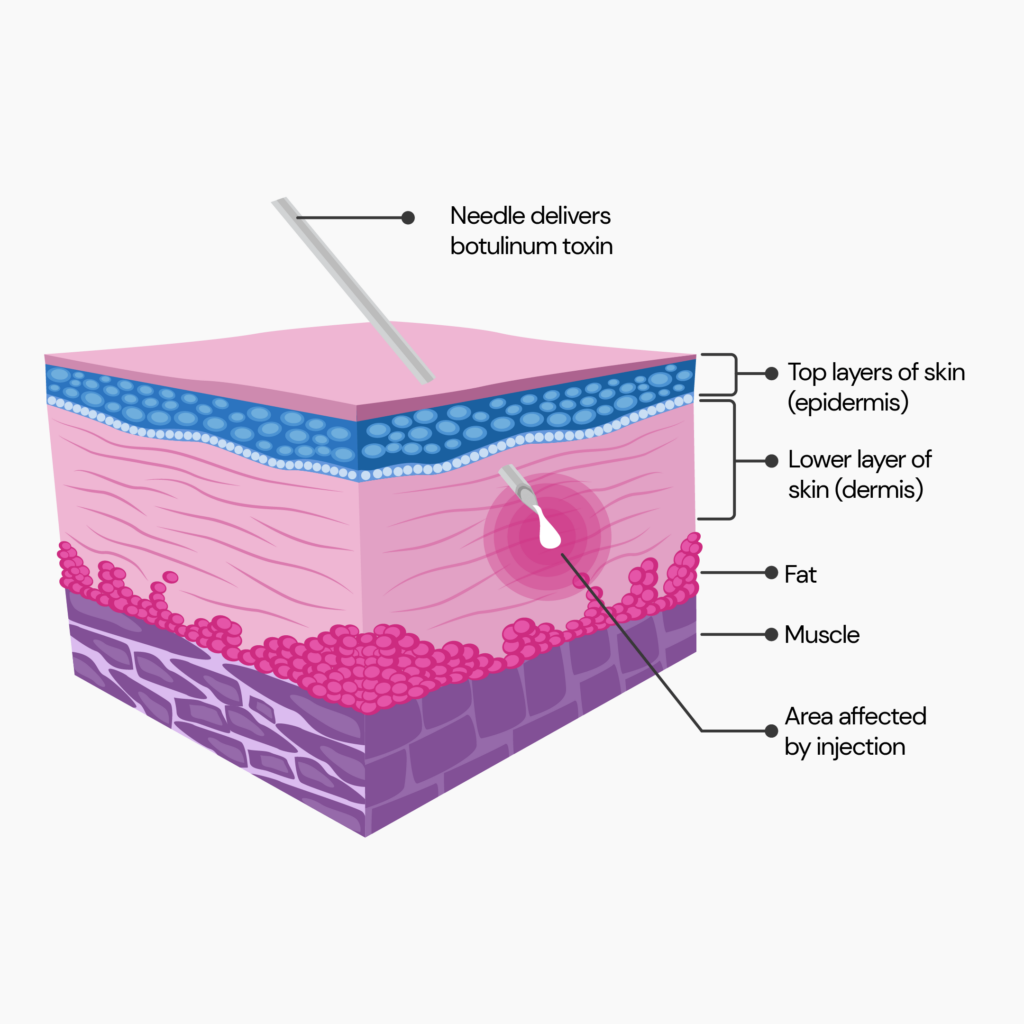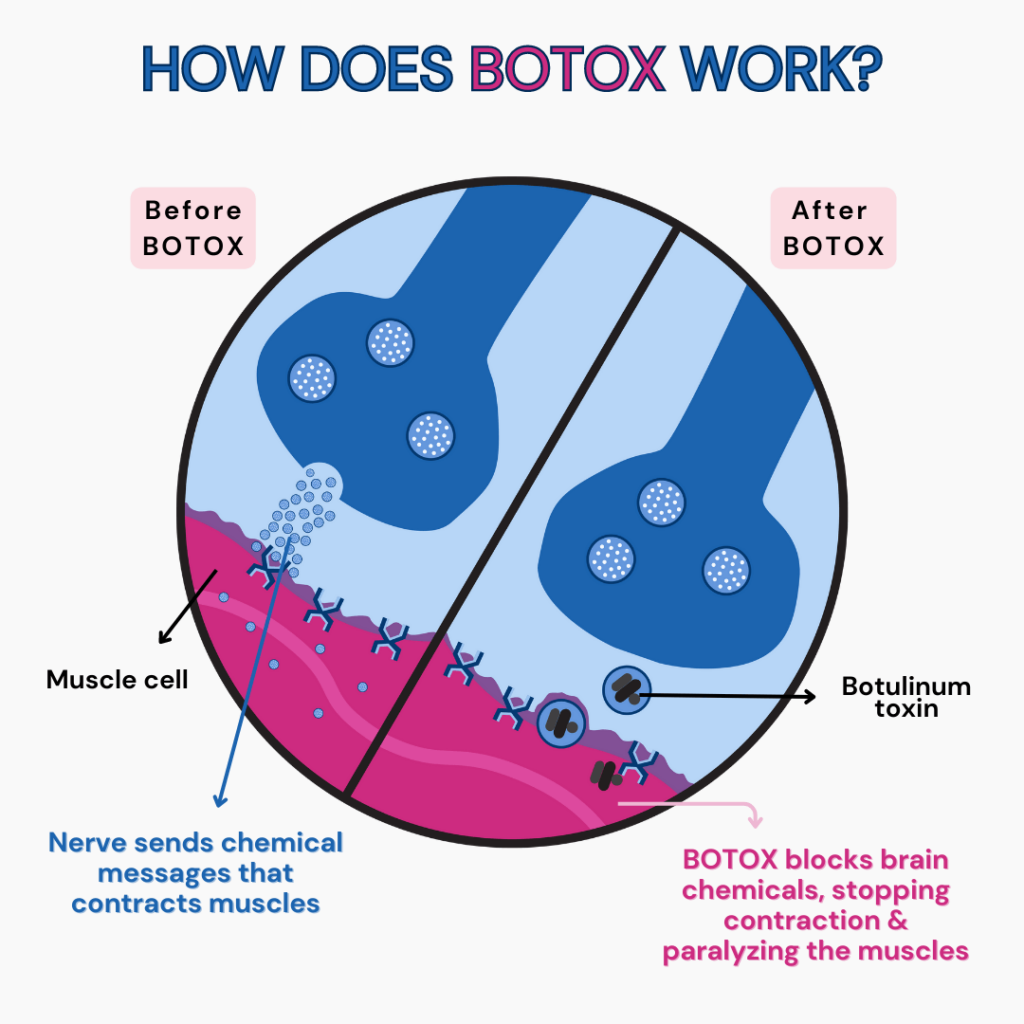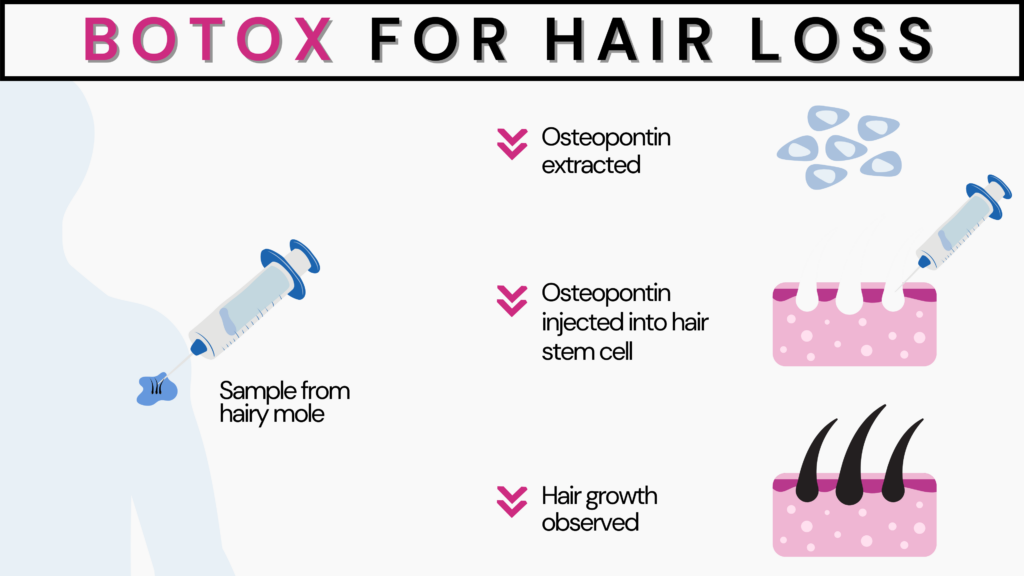Botox for hair loss - doesn’t this sound exciting?
Botox injections have become one of the favorite cosmetic procedures performed worldwide to help reduce the signs of aging.
Researchers are now exploring using osteopontin in skin moles to accelerate hair growth in people with baldness and hair fall.
If successful, this may soon replace the need for expensive hair transplantation surgeries and help people with alopecia areata get a permanent solution to balding.
What Are Botox Treatments?

Botulinum toxin (botox) is a drug made from the Clostridium botulinum bacterium.
This bacterium causes a rare disease called botulism, characterized by muscle weakness, breathing difficulties, and even death.
In small doses, botox can help relax facial muscles and reduce the appearance of wrinkles, fine lines, and frown lines.
Botox functions by inhibiting the release of certain neurotransmitters in the muscles.
It is also sometimes used to treat certain health conditions like muscle spasms, excessive sweating, and migraine.
Botox injections are prevalent cosmetic procedures in the United States, with 3 million injections opted annually.
How Have Botox Treatments Been Used In Haircare?
In recent times, there have been several products marketed as hair Botox.
However, these are not the same as Botox injectables for the skin.
Hair botox is just an attractive name given to hair nutrients created to give shinier, thicker, and lustrous hair.
Many of these hair nutrient masks contain collagen that coats the hair strands, making them look smoother, shinier, and thicker.
Such botox for hair loss products is available over-the-counter and has to be applied externally to the hair strands.
According to experts in the hair styling industry, these products don’t create any long-lasting impact and need to be used regularly to maintain the look.
Currently, researchers are exploring the idea of extracting a molecule from skin moles and using them to stimulate hair stem cells.
If successful, this could be the real ‘botox for hair loss’ people have been waiting for.

Why Do Moles Grow Dark Hair?
Melanocytes are cells that produce melanin.
Melanin is a pigment that gives color to our skin, eyes, and hair.
Sometimes, melanocytes group together and form patches on the skin, creating moles.
It is very common to see a single strand of thick hair growing from the center of skin moles in the body.
Researchers have now identified a particular compound in these moles that cause overproduction of these hair strands.
This compound also leads to hair growing darker and thicker.
They now want to explore the idea of using cells from the mole to create botox-like injectable solutions for the hair.
Botox For Hair Loss: Stem Cells From Mole Hair May Help Treat Baldness
Overview
In June 2023, Wang, Plikus, and their team published an article in Nature that explored the effect of hyperactive melanocyte cells on hair growth.
In simpler terms, this is being called botox for hair loss.
According to the researchers, melanocytic moles or nevi in the skin often display excessive hair growth.
The researchers believe that this could be because of hair stem cell hyperactivity.
They are exploring the idea of extracting the molecules that lead to hyperactivity and injecting them in balding areas of the scalp to promote hair regrowth.
Study Participants
This study was performed on mice models.
The effect of hyperactive melanocyte cells on human balding and hair loss is yet to be studied.
Design
The study identified a molecule named osteopontin in hairy moles that wasn’t found in significant amounts in regular skin cells.
Osteopontin is a type of signaling protein that plays a role in multiple biological processes, including:
- Migration of cells
- Cell survival
- Cell-mediated immune responses
- Inflammatory responses
According to the researchers, osteopontin could cause thicker, denser hair strands to grow from moles.
Observations
Osteopontin was predominantly found in higher quantities in aged melanocytes (senescent cells).
Researchers report that this signaling protein in senescent cells could activate dormant hair cells into their anagen phase (growth phase).
This could be why hairy moles develop thicker hair very quickly.
Hair loss is usually a result of the decrease in the quantity of signaling proteins in the hair follicles, which activate the anagen phase.
By extracting osteopontin and micro-injecting it into the cells on the scalp of mice models, the researchers were able to promote better hair growth.
They want to experiment with the same effect on human hair stem cells to see if this would solve alopecia and general hair loss.

Limitations
In some cases of hair loss, the stem cells of hair may have remained dormant for a very long time.
Researchers aren’t sure if such dormant cells can be reactivated again with this method.
Even with osteopontin, the new hair growth would depend on the features of the hair follicle.
So, it may not be possible to grow thicker and lustrous hair in everyone who uses this botox for hair loss.
If a person always had thin and brittle hair, they would probably regrow hair with similar features.
Future Directions
Right now, the only permanent cure for baldness is hair transplantation surgery.
Not many choose to opt for this invasive and expensive process.
Only a handful of FDA-approved alopecia products are on the market; these don’t work 100% for everyone.
As this research progresses, there is hope for people with balding and excessive hair fall issues to regrow their hair back without surgery.
Amplifica, a biopharmaceutical company based out of California, has just started human trials on this botox for hair loss treatment.
How Soon Can We See Botox For Hair Loss Treatments?
According to Amplifica, the first human dose was given on June 27th, 2023.
The researchers at this biotech company expect the study to be completed by the first quarter of 2024.
Meanwhile, other companies could also explore these botox for hair loss treatments and produce results earlier.
Here's an interesting topic for you
Oral Minoxidil For Hair Loss: A Complete Guide
Summary: Botox For Hair Loss
- Alopecia areata is a common problem affecting millions worldwide, with no permanent cure besides hair transplantation surgeries.
- Researchers are now experimenting with a new solution termed ‘Botox for hair loss’ by extracting a molecule from the melanocytes and injecting them into the site of hair loss.
- A study published in June 2023 reports that the hairy mole cells in the body contain a compound called osteopontin. This molecule may be able to trigger hair stem cells into their growth phase.
- When this compound was injected into balding hair sites in mice, the researchers noticed hair regrowth.
- This study is now being experimented on in human beings, and the results may be available in the first quarter of 2024.
- If the research is successful, this botox for hair loss treatment may replace the need for expensive transplantation surgeries.
References
https://www.ncbi.nlm.nih.gov/pmc/articles/PMC5782443/
https://www.nature.com/articles/s41586-023-06172-8
https://medlineplus.gov/botox.html
https://www.cdc.gov/botulism/index.html
https://www.mayoclinic.org/tests-procedures/botox/about/pac-20384658
https://www.ncbi.nlm.nih.gov/pmc/articles/PMC7874868/




